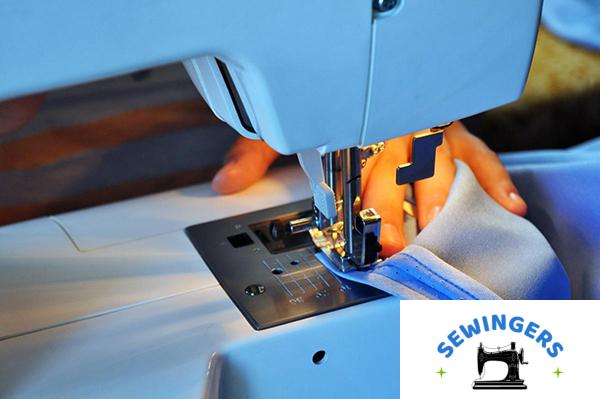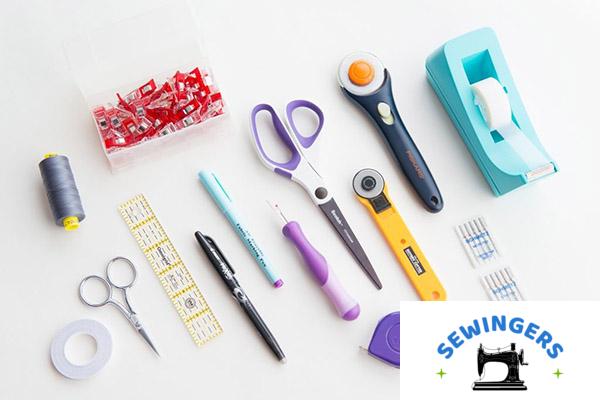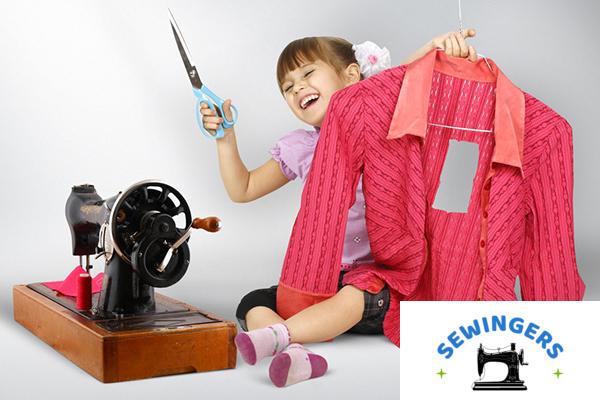The Best Seaming Guide: How to Sew a Seam

At its core, a seam is where two pieces of fabric come together and stay put. It’s the hidden hero of any sewing project—the place where fabric is joined with stitches to form everything from a pillowcase to a wedding gown. Whether you’re just learning or have been sewing for years, understanding the seam definition is essential. Without strong, properly sewn seams, even the most beautiful fabric won’t hold up over time.
Seams are more than just stitch lines. They have structure. The two main components are the seam line, which is where the stitching happens, and the seam allowance, the extra space between the stitch line and the raw edge of the fabric. That allowance—typically between ¼” and ⅝”—is what gives you room to press, trim, or finish. It’s a small detail with big consequences. Get it too narrow, and your seams may pop. Too wide, and your garment might not fit right.
Contents
Tools You Need Before Sewing a Seam
If you’ve ever stitched a seam only to rip it out five minutes later, chances are your tools—or lack of them—played a role. Having the right sewing equipment for seams isn’t just convenient; it’s the backbone of clean, strong, frustration-free sewing. Whether you’re hemming jeans or piecing a delicate bodice, a solid setup saves time and sanity.
Start with your sewing machine. It doesn’t need to be fancy, but it must be reliable. Get familiar with the needle plate, feed dogs, and the foot pedal—these three do the heavy lifting in seam construction. Most beginners overlook this, but adjusting your presser foot pressure for different fabrics can prevent slipping and puckering. Next, keep a seam gauge handy. It’s the unsung hero that ensures your seam allowances are consistent, especially on curves and tight corners. Trust me, an eighth of an inch off here or there adds up fast.
Tools Checklist for Beginners
Before you sit down to sew, make sure your kit includes these:
- A basic sewing machine with adjustable stitch length and width
- Seam gauge or a clear ruler with ⅛” marks
- Straight pins or fabric clips, plus a magnetic pin cushion
- Sharp shears and a pair of thread snips
- Steam iron—press every seam, every time
- Polyester thread (for durability) and at least 3 sizes of machine needles
Pressing is where a good seam becomes a great one. I always tell people: sew in haste, press in pride. A hot, steady iron can smooth out puckers, lock in stitches, and shape your garment as you build it. For curves or sleeve heads, a tailor’s ham works wonders—it’s one of those “old-school” tools you never regret owning.
Types of Seams and Their Uses
Seams aren’t just about holding fabric together—they shape your project’s final look, durability, and feel. After two decades of sewing everything from bridal gowns to motorcycle gear, I can tell you: choosing the right seam method makes all the difference. Whether you’re working with delicate silk or heavy denim, the way you finish your edges and manage your seam allowance will either elevate or ruin your work.
You’ve got your essentials: plain seams, French seams, flat-felled seams, overlocked seams, and lapped seams. Each has its place. If you’re sewing something lightweight and want the inside to look just as clean as the outside—think chiffon blouses or handmade lingerie—a French seam is your best friend. It hides raw edges entirely, no serger required. On the flip side, if you’re making something that takes a beating—jeans, overalls, or utility jackets—a flat-felled seam adds strength and trims down bulk. It’s not just neat; it’s nearly indestructible.
When to Use French Seam vs. Flat-Felled
Here’s where folks often get stuck—choosing between a French seam and a flat-felled seam. If you’re working with sheer fabric and want a polished finish, go French. It gives you clean, enclosed edges with minimal bulk. I use this seam regularly for formalwear and lightweight cotton tops. But if you’re after function and strength—especially for garments that need to hold up through wear, washing, and movement—go with a flat-felled. That’s the same seam they use on jeans for a reason.
A little-known tip? Flat-felled seams reduce seam bulk by around 20% compared to pressing open a plain seam and finishing it with an overlock. That matters when you’re sewing through multiple layers or need the seam to lay flat under topstitching.
Decorative vs. Functional Seams
Now, not every seam is doing hard labor. Some are purely for show. Lapped seams, for instance, offer a bold, topstitched look and work beautifully on felt, leather, or unlined coats. You’ll often see them in decorative applications where the raw edges won’t fray. On the other hand, overlocked seams—fast, stretchy, and secure—are the backbone of knitwear and activewear. They might not look fancy, but they work like a charm when you need both flexibility and clean edge finishing.
Here’s a quick seam method guide to help you decide:
- Plain Seam – Ideal for everyday sewing; simple and versatile. Use it with woven fabrics and reinforce if needed.
- French Seam – Best for lightweight or sheer fabrics. Adds a clean finish inside.
- Flat-Felled Seam – Strong and durable. Great for jeans, outerwear, and anything rugged.
- Overlocked Seam – Fast, stretchy, and perfect for knit fabrics or fast-paced production.
- Lapped Seam – Decorative and sturdy. Works well with non-fraying or thick fabrics

How to Sew a Basic Seam Step-by-Step
There’s no shortcut around it — sewing a clean, strong seam is a skill every beginner needs to master. This is where it all begins, whether you’re piecing together your first pillow cover or diving into dressmaking. The trick? Get the foundation right. That means proper fabric alignment, accurate pinning, and a steady straight stitch. Once you get these down, everything else starts falling into place.
Start by placing your two fabric pieces right sides together. Align the edges neatly. Take a minute here — if your fabric shifts, your whole seam could end up off. Use glass-head pins, spacing them every couple of inches, and keep them perpendicular to the edge. Most beginner-friendly patterns call for a ⅝” seam allowance, and that’s a good habit to get into unless your pattern says otherwise.
Stitching and Pressing: The Real Workhorses
Now, set your machine to a straight stitch with a stitch length around 2.5 mm — not too short, not too long. Start sewing about half an inch in, then do a quick backstitch to lock it. Go slow and steady down the seam line, pulling pins out as you reach them. Finish with another backstitch at the end to secure everything. And yes, always test on a fabric scrap first, especially if you’re switching fabrics. I’ve seen too many seams go wonky because the stitch tension wasn’t adjusted.
Once stitched, it’s time to press — not just for looks, but for structure. First, press the seam flat to set the stitches. Then press the seam open (unless your project calls for pressing to one side). Use steam if your fabric can take it. This little step makes a big difference in how your project turns out.
Here’s a checklist I give all my students:
- Line up your fabric with right sides together
- Pin carefully — don’t rush it
- Use a consistent seam allowance (⅝” unless noted)
- Backstitch at the beginning and end
- Press seams open for a cleaner finish
A 2024 community poll from PatternReview.com showed that over 70% of new sewists noticed fewer puckers once they started pressing every seam immediately. It’s one of those “aha” moments you don’t forget.
This is the kind of stuff I wish someone had drilled into me early on. Master this basic seam and suddenly your projects start to look and feel way more polished. And if you’re ever unsure mid-project, go back to this simple seam guide. It solves more issues than you think — especially when you’re stuck wondering why your pieces aren’t matching up.
Seam Allowance: Why It Matters and How to Measure
If you’ve ever ended up with a too-tight sleeve or a lopsided hem, chances are your seam allowance had something to do with it. Seam allowance—the space between your stitching line and the raw fabric edge—is one of those small details that makes or breaks a finished piece. Most commercial sewing patterns include anywhere from ¼ inch to ⅝ inch by default, but depending on the fabric or design, that might need adjusting. Think of it like insurance: a little extra margin now saves a lot of frustration later.
Adjusting Seam Allowance for Patterns
Now here’s the thing many new sewists don’t realize: not all patterns include seam allowances. Some—especially indie or vintage patterns—require you to add them yourself. Miss that detail, and suddenly your size 10 is fitting like a size 6. When working with digital or PDF patterns, double-check the instructions. I always say: measure once, mark twice, sew once. Use a clear ruler or seam gauge to draw in your seam lines directly onto the fabric if needed. And if you’re working with tricky fabric grainlines or curved seams, consider a wider allowance—it gives you more room to trim and adjust as you go.
Avoiding Cutting and Sewing Errors
Even experienced sewists slip up here, especially when rushing or cutting late at night (we’ve all been there). Cutting just ⅛ inch off consistently across a project can throw off your whole fit. The easiest fix? Set up your sewing machine with a magnetic seam guide, or mark key seam widths right onto your machine with washi tape. That visual cue saves time and keeps things even. I also recommend practicing a few lines on fabric scraps—get a feel for the seam spacing before diving into your main project.
July Update: What the Sewing Community Is Saying
This month on PatternReview.com and a few private Facebook sewing groups, there’s been a wave of discussion around improving accuracy—especially with custom-fit garments. A poll in one group showed that 72% of sewists who struggled with inconsistent sizing traced the issue back to uneven seam allowances. As more people use downloadable patterns that require adding your own margins, tools like rotary cutters, grid cutting mats, and tailor’s chalk have become more essential than ever.
Finishing Seams for a Clean Look
Nothing says “I know what I’m doing” quite like a well-finished seam. Whether you’re sewing for clients, selling on Etsy, or just want your handmade clothes to last longer than one wash, finishing your seams the right way makes a huge difference. It’s not just about aesthetics—it’s about preventing fraying, strengthening the garment from the inside out, and giving it that polished, pro-level feel.
Let’s be real—raw edges don’t hold up over time. They unravel, they weaken the seam, and they make all your hard work look unfinished. The good news? You’ve got several solid options to clean up those edges without needing a fancy setup. I’ll walk you through what’s worked best in real-life projects, from quick fixes to full-on couture methods.
Tried-and-True Seam Finishing Techniques
If you’ve got a basic machine with a zigzag setting, you’re already halfway there. The zigzag stitch is your go-to for woven fabrics when a serger isn’t in reach. Just run it along the raw edge, close but not too tight, and trim any fray that sneaks through. Simple. Reliable. Gets the job done.
Now, if you’re lucky enough to have a serger (also called an overlock machine), use it. It trims the seam allowance, wraps the edge in thread, and seals it—all in one pass. Once I started using a serger regularly, my garments started looking store-bought. According to a 2024 survey by Sewing Insights, nearly 7 in 10 sewists said they wouldn’t go back after incorporating serging into their routine.
Here are a few more finishing techniques worth keeping in your toolbox:
- Pinking Shears – Good for quick, low-fray fabrics. Great for muslins or when time’s short.
- Bias Binding – Gives your seams a beautiful finish—especially nice on unlined jackets or when the inside shows.
- French Seams – Excellent for sheer fabrics. No raw edges at all, just a clean fold.
And for the record, bias-bound seams are my go-to when I want to show off on the inside. Think of them like a secret flex—no one sees them unless you let them.
Common Seam Mistakes and How to Fix Them
Seams are supposed to hold your project together—not ruin it. But whether you’re sewing your first garment or your fiftieth quilt top, seam issues can sneak in. Puckering, uneven stitches, skipped spots, or seams that just won’t line up—these are the everyday battles. The good news? Most of these can be fixed without scrapping your work.
Fixing Puckered or Uneven Seams
Let’s start with the one that drives people nuts: puckering. It usually shows up when your thread tension is too tight or the fabric is being pulled instead of guided. Lightweight fabrics like rayon or silk are especially prone to this. First thing I always do? Back off the top thread tension by a notch or two. Then I make sure I’m not yanking the fabric through—just guiding it with a steady hand.
Want a quick fix?
- Lower your upper tension to a 3 or 4 for delicate fabrics.
- Use a fresh, fine needle (like a Microtex 70/10).
- Press the seam with steam—**not heat—**and don’t flatten it into oblivion.
According to a 2024 sewing habits survey by Threads Magazine, over 60% of experienced sewists admitted they still fight puckered seams, especially on synthetics. It’s not just you.
When to Rip—and How to Do It Right
Now, sometimes there’s no saving a seam. It’s crooked, skipped, or just plain wrong. That’s when the seam ripper earns its keep. If you’re going to unpick, do it clean. Work from the bobbin side, slide the ripper under every 3–4 stitches, and pull gently—don’t shred your fabric.
Once the seam is out, take a deep breath, re-pin, and stitch slowly. It helps to:
- Switch to a shorter stitch length (2.0–2.5mm for woven fabrics).
- Stabilize the fabric with tear-away if it’s stretchy or slippery.
- Test your seam on a scrap first—yes, every time.
Also, check your needle. If you’ve gone through two layers of denim and then switch to lawn without changing it? Yeah, that dull tip will skip stitches like a scratched record.
Sewing troubleshooting is just part of the game. Even after two decades at the machine, I still stop to tweak tension or re-align seams. It’s not a sign of failure—it’s how you get clean, professional results.






